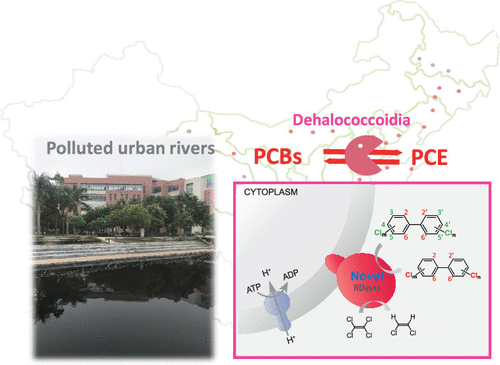当前位置:
X-MOL 学术
›
Environ. Sci. Technol.
›
论文详情
Our official English website, www.x-mol.net, welcomes your
feedback! (Note: you will need to create a separate account there.)
Organohalide-Respiring Bacteria in Polluted Urban Rivers Employ Novel Bifunctional Reductive Dehalogenases to Dechlorinate Polychlorinated Biphenyls and Tetrachloroethene.
Environmental Science & Technology ( IF 10.8 ) Pub Date : 2020-06-18 , DOI: 10.1021/acs.est.0c01569 Lan Qiu 1 , Wenwen Fang 1 , Haozheng He 1 , Zhiwei Liang 1 , Yangyue Zhan 1 , Qihong Lu 1 , Dawei Liang 2 , Zhili He 1 , Bixian Mai 3 , Shanquan Wang 1
Environmental Science & Technology ( IF 10.8 ) Pub Date : 2020-06-18 , DOI: 10.1021/acs.est.0c01569 Lan Qiu 1 , Wenwen Fang 1 , Haozheng He 1 , Zhiwei Liang 1 , Yangyue Zhan 1 , Qihong Lu 1 , Dawei Liang 2 , Zhili He 1 , Bixian Mai 3 , Shanquan Wang 1
Affiliation

|
Polluted urban river sediments could be a sink of persistent and toxic polychlorinated biphenyls (PCBs) in urban areas and provide desired growth niches for organohalide-respiring bacteria (OHRB). In this study, microcosms were set up with surface sediments of nationwide polluted urban rivers in China, of which 164 cultures could dechlorinate tetrachloroethene (PCE) to dichloroethenes (DCEs) and to vinyl chloride and/or ethene. Further in vivo tests showed extensive PCB dechlorination with different pathways in 135 PCE pregrown cultures. Taking reductive dechlorination of PCB180 (2345-245-CB) as an example, 121 and 14 cultures preferentially removed flanked para- and meta-chlorines, respectively. Strikingly, all in vitro assays with the 135 PCE pregrown cultures showed identical PCB dechlorination pathways with their living cultures, implying the involvement of bifunctional reductive dehalogenases (RDases) to dechlorinate both PCBs and PCE. Further 16S rRNA and RDase gene-based analyses, together with enantioselective dechlorination of chiral PCBs, suggested that Dehalococcoides and Dehalogenimonas in the 135 cultures largely employed distinctively different novel bifunctional RDases to catalyze PCB/PCE dechlorination. Quantitative assessment of the community assembly process with the modified stochasticity ratio (MST) indicated three different stages in enrichment of OHRB. The second stage, as the only one controlled by stochastic processes (MST > 0.5), required extra attention in monitoring community successional patterns to minimize stochastic variance for enriching the PCB/PCE-dechlorinating OHRB.
中文翻译:

在污染的城市河流中呼吸有机卤化物的细菌利用新型的双功能还原脱卤酶对多氯联苯和四氯乙烯进行脱氯。
受污染的城市河流沉积物可能是城市地区持久性和有毒多氯联苯(PCB)的汇,并为呼吸有机卤化物的细菌(OHRB)提供了理想的生境。在这项研究中,建立了覆盖全国污染城市河流的表层沉积物的缩影,其中164种文化可以将四氯乙烯(PCE)脱氯成二氯乙烯(DCE)和氯乙烯和/或乙烯。进一步的体内测试表明,在135种PCE预生长培养物中,PCB广泛地以不同的途径脱氯。服用PCB180(2345-245-CB)的还原脱氯作为一个例子,121个14文化优先除去两侧对位-和间位-chlorines,分别。引人注目的是所有体外用135种PCE预先生长的培养物进行的分析表明,PCB与其生活的培养物具有相同的PCB脱氯途径,这表明双功能还原脱卤酶(RDase)参与了PCB和PCE的脱氯。进一步的基于16S rRNA和RDase基因的分析,以及手性PCB的对映选择性脱氯,提示Dehalococcoides和Dehalogenimonas在135种文化中,大量使用了截然不同的新型双功能RDase催化PCB / PCE脱氯。修改后的随机率(MST)对社区组装过程的定量评估表明,OHRB的富集过程分为三个不同阶段。第二阶段是唯一受随机过程控制的阶段(MST> 0.5),在监视社区演替模式时需要格外注意,以最大程度减少随机变化,以丰富PCB / PCE除氯的OHRB。
更新日期:2020-07-21
中文翻译:

在污染的城市河流中呼吸有机卤化物的细菌利用新型的双功能还原脱卤酶对多氯联苯和四氯乙烯进行脱氯。
受污染的城市河流沉积物可能是城市地区持久性和有毒多氯联苯(PCB)的汇,并为呼吸有机卤化物的细菌(OHRB)提供了理想的生境。在这项研究中,建立了覆盖全国污染城市河流的表层沉积物的缩影,其中164种文化可以将四氯乙烯(PCE)脱氯成二氯乙烯(DCE)和氯乙烯和/或乙烯。进一步的体内测试表明,在135种PCE预生长培养物中,PCB广泛地以不同的途径脱氯。服用PCB180(2345-245-CB)的还原脱氯作为一个例子,121个14文化优先除去两侧对位-和间位-chlorines,分别。引人注目的是所有体外用135种PCE预先生长的培养物进行的分析表明,PCB与其生活的培养物具有相同的PCB脱氯途径,这表明双功能还原脱卤酶(RDase)参与了PCB和PCE的脱氯。进一步的基于16S rRNA和RDase基因的分析,以及手性PCB的对映选择性脱氯,提示Dehalococcoides和Dehalogenimonas在135种文化中,大量使用了截然不同的新型双功能RDase催化PCB / PCE脱氯。修改后的随机率(MST)对社区组装过程的定量评估表明,OHRB的富集过程分为三个不同阶段。第二阶段是唯一受随机过程控制的阶段(MST> 0.5),在监视社区演替模式时需要格外注意,以最大程度减少随机变化,以丰富PCB / PCE除氯的OHRB。











































 京公网安备 11010802027423号
京公网安备 11010802027423号